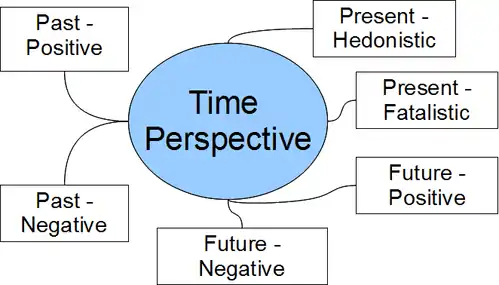< Motivation and emotion < Tutorials

Tutorial 10: Time perspective
| Resource type: this resource contains a tutorial or tutorial notes. |
This is the tenth tutorial for the Motivation and emotion unit of study.
Overview
This tutorial is about the psychology of time and, more specifically, Zimbardo's model of time perspective and how it relates to motivation and emotion.
Zimbardo Time Perspective Inventory
Before considering theory about time perspective:
- Complete the Zimbardo Time Perspective Inventory (ZTPI) (56 out of the 61 items count towards the 5 ZTPI factors; 5 are filler items).
- Enter your 5 factor scores into this Google Form
Time perspective
Time perspective can be broadly divided into:
- Past
- Present
- Future
Zimbardo (2009) further divides time perspective as shown in Figure 1.

Figure 1. Six possible time perspective factors, based on Zimbardo (2009).
Key time perspective principles:
- TP influences thoughts, feelings, and behaviour unconsciously
- Each TP has benefits, but excesses create negative consequences
- TPs are learned through personal experience
For more information, see an overview of time perspective types (thetimeparadox.com)
Compare scores
- Compare your ZTPI scores with the:
- Norms:
- Past Negative (Mdn = 3.00)
- Past Positive (Mdn = 3.22)
- Present Fatalism (Mdn = 2.33)
- Present Hedonism (Mdn = 3.93)
- Future (Mdn = 3.38)
- Transcendental Future
- "Optimal" profile
- The worst time-perspective profile includes:
- Norms:
Video
- Watch and discuss video: Philip Zimbardo prescribes a healthy take on time (Phillip Zimbardo, 6:31 min, TED talk, 2009)
Books
- Zimbardo's two books on this topic are:
Book chapter development
- Guided by student questions
Recording
- Tutorial 10 recording, 2020
See also
- Instructor notes
- Time perspective (Wikiversity)
- Time perspective (Book chapters)
- 20 emotions (Previous tutorial)
- Positive psychology (Next tutorial)
- Unconscious motivation (Lecture)
References
Zimbardo, P. G. & Boyd, J. N. (2009). The time paradox: Using the new psychology of time to your advantage. New York, NY: Free Press.
This article is issued from Wikiversity. The text is licensed under Creative Commons - Attribution - Sharealike. Additional terms may apply for the media files.